#food research and development companies
Link
The global raw sugar market is expected to rise at a 4.6% Compound Annual Growth Rate (CAGR) from 2022 to 2032, as conducted by industry and market research on raw sugar. Food Research Lab aims to assist food and beverage industries in creating new food products that incorporate raw cane sugar instead of refined sugar.
#global research#market analysis#Organic Raw Cane Sugar#organic raw sugar#raw cane#raw cane sugar#unrefined sugar#food#food products#food research#foodresearchlab#food research and development companies#food industries#beverage industries#food and beverage
1 note
·
View note
Text

hey tumblr what do you think you're doing letting this ad go through
#asd#researched this. this lawsuit is basically saying that toxic heavy metals in baby good causes autism#there ARE papers on ASD and heavy metal toxicity and it has been found in 3 studies so far (idk how credible they are)#that autistic people have higher concentrations of toxic heavy metals in their systems than allistic people#which leads to an 'increase in severe autism symptoms'#basically i just think it means autistic people having these adverse side effects make them more uncomfortable and more 'autistic'#which just means whatever inconvenience they place on their parents p much#but there is NO LINK FOUND between DEVELOPING autism after eating baby foods with lots of heavy metals in them#so what the actual hell is this doing here?? is there something im missing? bc please tell me if theres something real im missing here#the lawsuit from what i see is being based upon assumption. not actual fact#and hell im skeptical of MOST autism studies especially if they say what 'causes' it#if theyre making a lawsuit against baby food companies putting lead or mercury in their foods then yeah that's enough of a lawsuit itself#idk why asd is being brought into it
19 notes
·
View notes
Text
How to Conduct Market Research for Food Product Development?
Learn key steps to conduct effective market research for food product development, from identifying trends to understanding customer needs. For more detail visit here : https://www.philomathresearch.com/blog/2024/09/09/how-to-conduct-market-research-for-food-product-development/
#market research#market research for food product development#market research companies#primary market research#quantitative data
0 notes
Text
The Best News of Last Week
1. Arizona governor Ok's over the counter birth control

Arizona Gov. Katie Hobbs (D) has expanded access to over-the-counter birth control that will “soon be available to Arizonans,” according to a press release.
Arizonans 18 and older will soon be able to go to their local pharmacy and purchase oral contraceptives without a doctor’s prescription.
2. ‘Great news’: EU hails discovery of massive phosphate rock deposit in Norway

A massive underground deposit of high-grade phosphate rock in Norway, pitched as the world’s largest, is big enough to satisfy world demand for fertilisers, solar panels and electric car batteries over the next 50 years, according to the company exploiting the resource. About 90% of the world’s mined phosphate rock is used in agriculture for the production of phosphorous for the fertiliser industry, for which there is currently no substitute.
3. U.S. Is Destroying the Last of Its Once-Vast Chemical Weapons Arsenal

Decades behind its initial schedule, the dangerous job of eliminating the world’s only remaining declared stockpile of lethal chemical munitions will be completed as soon as Friday.
4. Chinese scientists create edible food packaging to replace plastic
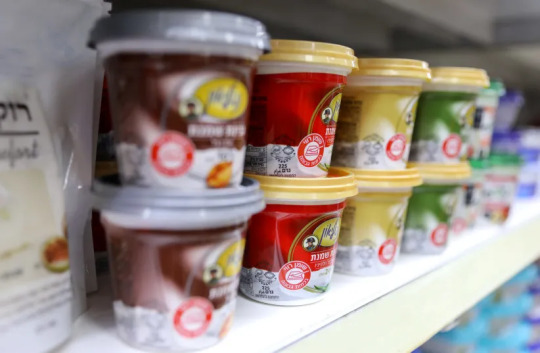
By incorporating certain soy proteins into the structure, Chinese University of Hong Kong scientists successfully created edible food packaging.
5. World's 1st 'tooth regrowth' medicine moves toward clinical trials in Japan

A Japanese research team is making progress on the development of a groundbreaking medication that may allow people to grow new teeth, with clinical trials set to begin in July 2024. The tooth regrowth medicine is intended for people who lack a full set of adult teeth due to congenital factors.
6. No Longer Endangered: The Bald Eagle is an Icon of the ESA

When the Endangered Species Act (ESA) was enacted in 1973, bald eagle population numbers across the country showed that the species was close to disappearing. Before the ESA, in the 1950s and ‘60s, eagles were shot routinely despite the protection. The ESA listing helped bring public attention to the issue.
Through the early 1970s and into the early ‘80s, numbers increased gradually. Then, as you got into the ‘90s, there was still gradual growth. From the late ‘90s into the 2000s, the population really exploded. There was a doubling rate of every several years or so for a while.
7. Deforestation in Brazil's Amazon drops 34% in first half 2023

Deforestation in Brazil's Amazon fell 34% in the first half of 2023, preliminary government data showed on Thursday, hitting its lowest level in four years as President Luiz Inacio Lula da Silva institutes tougher environmental policies.
Data produced by Brazil's national space research agency Inpe indicated that 2,649 square km (1,023 square miles) of rainforest were cleared in the region in the half year, the lowest for the period since 2019.
----
That's it for this week :)
This newsletter will always be free. If you liked this post you can support me with a small kofi donation:
Support this newsletter ❤️
Also don’t forget to reblog.
5K notes
·
View notes
Text
Flint, Michigan, has one of the [United States]'s highest rates of child poverty — something that got a lot of attention during the city's lead water crisis a decade ago. And a pediatrician who helped expose that lead problem has now launched a first-of-its-kind move to tackle poverty: giving every new mother $7,500 in cash aid over a year.
A baby's first year is crucial for development. It's also a time of peak poverty.
Flint's new cash transfer program, Rx Kids, starts during pregnancy. The first payment is $1,500 to encourage prenatal care. After delivery, mothers will get $500 a month over the baby's first year.
"What happens in that first year of life can really portend your entire life course trajectory. Your brain literally doubles in size in the first 12 months," says Hanna-Attisha, who's also a public health professor at Michigan State University.
A baby's birth is also a peak time for poverty. Being pregnant can force women to cut back hours or even lose a job. Then comes the double whammy cost of child care.
Research has found that stress from childhood poverty can harm a person's physical and mental health, brain development and performance in school. Infants and toddlers are more likely than older children to be put into foster care, for reasons that advocates say conflate neglect with poverty.
In Flint, where the child poverty rate is more than 50%, Hanna-Attisha says new moms are in a bind. "We just had a baby miss their 4-day-old appointment because mom had to go back to work at four days," she says...
Benefits of Cash Aid
Studies have found such payments reduce financial hardship and food insecurity and improve mental and physical health for both mothers and children.
The U.S. got a short-lived taste of that in 2021. Congress temporarily expanded the child tax credit, boosting payments and also sending them to the poorest families who had been excluded because they didn't make enough to qualify for the credit. Research found that families mostly spent the money on basic needs. The bigger tax credit improved families' finances and briefly cut the country's child poverty rate nearly in half.
"We saw food hardship dropped to the lowest level ever," Shaefer says. "And we saw credit scores actually go to the highest that they'd ever been in at the end of 2021."
Critics worried that the expanded credit would lead people to work less, but there was little evidence of that. Some said they used the extra money for child care so they could go to work.
As cash assistance in Flint ramps up, Shaefer will be tracking not just its impact on financial well-being, but how it affects the roughly 1,200 babies born in the city each year.
"We're going to see if expectant moms route into prenatal care earlier," he says. "Are they able to go more? And then we'll be able to look at birth outcomes," including birth weight and neonatal intensive care unit (NICU) admissions.
Since the pandemic, dozens of cash aid pilots have popped up across the nation. But unlike them, Rx Kids is not limited to lower-income households. It's universal, which means every new mom will get the same amount of money. "You pit people against each other when you draw that line in the sand and say, 'You don't need this, and you do,' " Shaefer says. It can also stigmatize families who get the aid, he says, as happened with traditional welfare...
So far, there's more than $43 million to keep the program going for three years. Funders include foundations, health insurance companies and the state of Michigan, which allocated a small part of its federal cash aid, known as Temporary Assistance for Needy Families.
Money can buy more time for bonding with a baby
Alana Turner can't believe her luck with Flint's new cash benefits. "I was just shocked because of the timing of it all," she says.
Turner is due soon with her second child, a girl. She lives with her aunt and her 4-year-old son, Ace. After he was born, her car broke down and she was seriously cash-strapped, negotiating over bill payments. This time, she hopes she won't have to choose between basic needs.
"Like, I shouldn't have to think about choosing between are the lights going to be on or am I going to make sure the car brakes are good," she says...
But since she'll be getting an unexpected $7,500 over the next year, Turner has a new goal. With her first child, she was back on the job in less than six weeks. Now, she hopes she'll be able to slow down and spend more time with her daughter.
"I don't want to sacrifice the time with my newborn like I had to for my son, if I don't have to," she says."
-via NPR, March 12, 2024
#united states#flint michigan#michigan#cash aid#basic income#poverty#poverty relief#child poverty#mothers#pregnancy#prenatalcare#healthcare#healthcare access#public health#child development#good news#hope
349 notes
·
View notes
Text
Self Development and Astrology( Vedic Astrology).
There are four main important houses in Astrology called as "Kendra house" ie one, four, seven and ten.
Rest all other houses are supporting houses.
First 🏠 house, is the house of self and personality. Sun is exalted in first house, because Sun is soul, so if you know your weakness and strength and work on your body regularly ( as Mars has lordship of first house) then no outside enemy can defeat you. And if your body is in good state then you can enjoy all the pleasures of the world..
Fourth house The most important house, once you get defeated emotionaly then nothing can help you, it is said, once, you loose emotionally you loose everything in life
So never depend Emotionally on anyone. Never give control of your emotional body to any one.
Jupiter is exalted in fourth house, because even if you loose everything in life but hold on to your morality, you will get everything in life again.
For native who has their Jupiter in two, six, four and ten it is better if you go in work related to Jupiter like counselling, and teaching, spirituality, and work related to religion.
Next house which is important is seventh House, is house of your focus and attention .
This house tells you, where you give your focus that area will expand, also tells you focus on your partnership or network, because your network is your networth, you finally become like the person with whom you spend most time with
Next house is your house of Karma, or the tenth house If you know what work makes you happy or you do what you enjoy,then you are the most carefree and happy person.
Tenth house is opposite to fourth house, it means, once you work hard, fourth house related things like luxury and comfort will come to you easily.
If you have Mercury in 10th house or fourth house, then would get success when you involve in communication, speech or develop some kind of skill
If you have Venus in fourth or tenth then it is better you do work related to cosmetics, luxury, apparels, textile.
If you have SUN in fourth or tenth then it is better you work alone and independent. You can be good politician as well
If you have Moon in fourth or in tenth then you can get involved in food related job, or in psychology or get in job which has traveling..
Mars in second or in tenth house, then involve in land, property, house, real estate, or in Army, police or in sports. Such natives have so much of energy when someone assigns them task they will finish it fast.
Saturn eighth or in tenth house, should take work as their service,they can go in politics, or in service related industry, here Saturn will give you success slowly with time .
If your tenth lord is in first house, then do work related to self improvement and your body, such natives are great and can achieve alot in their career on their own.
Tenth lord second house, do work with your family, or related to speech and cooking.
Tenth lord in third house, do work related to skill development, sports, with siblings, media, communication, commission.
Tenth lord in fourth are extremely good, because person would get all luxurious and comfort by his work. You can work for masses, also home related job or service.
Tenth lord in fifth is also good, you can go in teaching and learning.
Tenth lord in sixth, you can work in charity, for pets, as doctors, healers, health workers, as auditor.
Tenth lord in seventh, it is better to go for business.
Tenth lord in eighth, research, soy, insurance, Bank, occult, astrology.
Tenth lord in ninth, good, you can go in counselling, teaching spirituality, religious work
Tenth lord in tenth is good, you are hard working and can work in any job.
Tenth lord in eleventh, you can work as free Lancer, create multiple source of income, work in social media
Tenth lord in twelfth, you can work in foreign country, or in foreign company, MNCs, import export, hospital, yoga, meditation.
One, four, Sven and ten are actual spine of your chart and you need to constantly work in these houses, rest all houses are by product.

258 notes
·
View notes
Text
Mycotech: The Indonesian Startup Biofabricating novel materials from mushrooms

Called Mycotech Lab, the company was inspired by tempeh, the traditional Indonesian food made from fermented soybeans, and came up with its own technology to grow its ethical and carbon-friendly mycelium-based materials.

Mycotech Lab decided to experiment with the fermentation process used to make tempeh to make a new fabric out of the complex root structure of mushrooms, otherwise known as mycelium. It was a lengthy trial-and-error process that kicked off in 2016, but “finally, we found one mushroom with a mycelium that can be made into binding material,” said Erlambang Ajidarma, head of research at the startup, in conversation with Reuters.

The final product, developed with fungus grown on sawdust that then gets scraped off and dried and cut into different sizes, is Mylea, a fibrous but tough material that acts just like the real thing. It’s waterproof, pliable, durable, and most importantly, is far more sustainable than existing plastic-based synthetic leathers or carbon-intensive real leather made from hide.
Mycotech also uses natural dye extracted from roots, leaves and food waste in the region to colour their leather alternative, which again is a process that is far less polluting than traditional tanning processes used for real cowhide that leaves behind solid and liquid waste that contains chromium and other hazardous compounds.
Since its inception, Mycotech has managed to grow its client base with no marketing budget because the demand for sustainable alternatives has grown alongside awareness of the damaging effects of animal-based materials in the fashion industry.
We the Fungi

Bio Binderless Board | Sustainable non-adhesive binder board from Mylea™ byproduct to meet modern architectural and design standards
Biodegradable Solid-Composite | Utilizing mushroom mycelium that grows and is shaped into desired form and utilities.
#solarpunk#solarpunk business#solarpunk business models#solar punk#startup#reculture#indonesia#mushroom materials#materials innovation#solarpunk innovation
79 notes
·
View notes
Text
https://news.ku.dk/all_news/2024/06/researchers-invent-one-hundred-percent-biodegradable-barley-plastic/

From the article; Enormous islands of it float in our oceans and microscopic particles of it are in our bodies. The durability, malleability and low cost of plastics has made them ubiquitous, from packaging to clothing to aircraft parts. But plastics have a downside. Plastics contaminate nature, are tough to recycle and their production emits more CO2 than all air traffic combined.
Now, researchers at the University of Copenhagen’s Department of Plant and Environmental Sciences have invented a new material made from modified starch that can completely decompose in nature – and do so within only two months. The material is made using natural plant material from crops and could be used for food packaging, among many other things.
"We have an enormous problem with our plastic waste that recycling seems incapable of solving. Therefore, we’ve developed a new type of bioplastic that is stronger and can better withstand water than current bioplastics. At the same time, our material is one hundred percent biodegradable and can be converted into compost by microorganisms if it ends up somewhere other than a bin," says Professor Andreas Blennow of the Department of Plant and Environmental Sciences.
Only about nine percent of plastic is recycled globally, with the rest being either incinerated or winding up in nature or dumped into enormous plastic landfills.
Bioplastics already exist, but the name is misleading says Professor Blennow. While today’s bioplastics are made of bio-derived materials, only a limited part of them is actually degradable, and only under special conditions in industrial composting plants.
"I don't find the name suitable because the most common types of bioplastics don't break down that easily if tossed into nature. The process can take many years and some of it continues to pollute as microplastic. Specialized facilities are needed to break down bioplastics. And even then, a very limited part of them can be recycled, with the rest ending up as waste," says the researcher.
Starch from barley and sugar industry waste
The new material is a so-called biocomposite and composed of several different substances that decompose naturally. Its main ingredients, amylose and cellulose, are common across the plant kingdom. Amylose is extracted from many crops including corn, potatoes, wheat and barley.
Together with researchers from Aarhus University, the research team founded a spinoff company in which they developed a barley variety that produces pure amylose in its kernels. This new variety is important because pure amylose is far less likely to turn into a paste when it interacts with water compared to regular starch. Cellulose is a carbohydrate found in all plants and we know it from cotton and linen fibers, as well as from wood and paper products. The cellulose used by the researchers is a so-called nanocellulose made from local sugar industry waste. And these nanocellulose fibers, which are one thousand times smaller than the fibers of linen and cotton, are what contribute to the material’s mechanical strength.
"Amylose and cellulose form long, strong molecular chains. Combining them has allowed us to create a durable, flexible material that has the potential to be used for shopping bags and the packaging of goods that we now wrap in plastic," says Andreas Blennow.
The new biomaterial is produced by either dissolving the raw materials in water and mixing them together or by heating them under pressure. By doing so, small 'pellets' or chips are created that can then be processed and compressed into a desired form.
Thus far, the researchers have only produced prototypes in the laboratory. But according to Professor Blennow, getting production started in Denmark and many other places in the world would be relatively easy.
"The entire production chain of amylose-rich starch already exists. Indeed, millions of tons of pure potato and corn starch are produced every year and used by the food industry and elsewhere. Therefore, easy access to the majority of our ingredients is guaranteed for the large-scale production of this material," he says.
Could reduce plastic problem
Andreas Blennow and his fellow researchers are now processing a patent application that, once it has been approved, could pave the way for production of the new biocomposite material. Because, despite the huge sums of money being devoted to sorting and recycling our plastic, the researcher does not believe that it will really be a success. Doing so should be seen as a transitional technology until we bid fossil-based plastics a final farewell.
"Recycling plastic efficiently is anything but straightforward. Different things in plastics must be separated from each other and there are major differences between plastic types, meaning that the process must be done in a safe way so that no contaminants end up in the recycled plastic. At the same time, countries and consumers must sort their plastic. This is a massive task that I don’t see us succeeding at. Instead, we should rethink things in terms of utilizing new materials that perform like plastic, but don’t pollute the planet," says Blennow.
The researcher is already collaborating with two Danish packaging companies to develop prototypes for food packaging, among other things. He envisions many other uses for the material as well, such as for the interior trims of cars by the automotive industry. Though it is difficult to say when this biofriendly barley-based plastic will reach the shelves, the researcher predicts that the new material may become a reality in the foreseeable future.
“It's quite close to the point where we can really start producing prototypes in collaboration with our research team and companies. I think it's realistic that different prototypes in soft and hard packaging, such as trays, bottles and bags, will be developed within one to five years," concludes Andreas Blennow.
#good news#plastics#plastic pollution#plastic pollution solutions#environmentalism#science#environment#microplastics#bioplastics#recycling#plastic recycling#sustainability
63 notes
·
View notes
Note
Why does everything seem like you can only pick one of the two social systems of socialism/communism vs capitalism instead of a mixed economy? Like I live in a country with mixed economy social system, healthcare, lifestyle, telecommunications, public transport, etc, all have a govt/public system funded by taxes and kept at the lowest prices possible vs a privatised funded version where you get relatively finer services. And some systems kept completely out of private like research, military, prisons. I mean individual corruption never really stops, in both systems, so why not mix both to keep it in check? Like the lowest prices available as well as maximum upper limits set by the govt for things like food, make sure capitalism doesnt go haywire, but also allows it to form a competitive system for development. 🤔🤔🤔
there's nothing 'mixed' about this system. under capitalism, the state exists as an expression of bourgeois interests to maintain and enable the private sector, not as a separate thing (e.g.: who enforces private property rights? who gets called to physically prevent you from violating them using violence?). infrastructure and some degree of social safety net being paid for by the government are good for capital, because capitalists use infrastructure and need workers who are Alive. (to say nothing of the fact that 'government/public-funded' usually means that the government is writing huge checks to any myriad of private companies who are happily pocketing it). what you're describing is a capitalist system with a welfare state -- a fully capitalist system, in which the working class has to sell their labour to survive and that labour is directed towards the reproduction of capital rather than towards the fulfillment of any societal needs.
385 notes
·
View notes
Link
The video provides a brief idea of how pepper consumption influences global markets and how the food research lab helps identify the variants of black pepper while developing new products.
#pepper#food#organic pepper#pepper consumption#black pepper#new products#food product#food production#pepper production#market analysis#food research#food research and development companies#foodresearchlab
1 note
·
View note
Text
Shahar Kadman, 34, was murdered by Hamas terrorists while trying to escape the Nova festival on October 7th. He is survived by his wife Ayelet, his parents Yoram and Ronit, and his siblings Shira, and Orna, Omri, who wrote, “You were found lying on the dance floor with your friends, who were like a loving family to you."Shachar was passionate about environmental conservation and is remembered as exceptionally bright, hardworking, creative, and witty by his colleagues at the Tara Dairy Company. He earned his master’s degree in biochemistry, food science, and nutrition from the Hebrew University of Jerusalem, and his research professor honored his memory by sharing his scientific achievements. Shachar developed biodegradable, plastic-free capsules that can be used as eco-friendly packaging to replace polystyrene foamed particles. His professor described this invention as “a product of great ingenuity, knowledge, and patience.” Shachar was a true friend, environmentalist, and practitioner of Tikkun Olam, and his sister Shira wrote, “My beloved little brother, [go] beat Grandpa at backgammon and get annoyed at the smell of Grandma Shoshi’s toothpaste, and give them a hug from us.”May Shachar’s memory forever be a blessing.

#israel#i/p#stand with israel#bring the hostages home#Arabian Sea#bring them home#bring them home now#hamas is isis#jumblr#am yisrael chai pray for the hostages טאמבלר#ישראל#gaza#antisemitism#hostages#fuck hamas#i stand with israel#israel palestine conflict#pro israel#israel hamas war
60 notes
·
View notes
Text
How to Conduct Market Research for Food Product Development?
Food product development is an intricate process involving numerous stages, from ideation and concept development to product launch. One of the most crucial steps in this journey is market research, which helps food companies understand consumer preferences, identify gaps in the market, and develop products that are likely to succeed. Conducting comprehensive market research can make or break the success of a new food product. For primary market research companies like Philomath Research, understanding the nuances of this process is essential.
1. Introduction to Food Product Development Market Research
Food product development involves creating new food products or improving existing ones. Market research plays a pivotal role in this process by providing insights into consumer behavior, market trends, competitive analysis, and potential product positioning. This blog will explore the various steps and methodologies involved in conducting market research for food product development.
2. Understanding the Food Market Landscape
Before diving into product development, it is essential to understand the current landscape of the food market. This involves analyzing market size, growth rate, segmentation, key players, and emerging trends. Key areas to focus on include:
Market Segmentation: Identify the different segments within the food market (e.g., organic, vegan, gluten-free, convenience foods) and their respective growth rates.
Consumer Demographics: Analyze the demographics of the target audience, including age, gender, income level, and geographic location.
Market Trends: Study current and emerging trends in the food industry, such as plant-based diets, sustainable packaging, or functional foods that offer health benefits.
Competitive Analysis: Identify key competitors, their product offerings, pricing strategies, and market positioning.
3. Defining Research Objectives
Clear research objectives are crucial for any market research project. In the context of food product development, some common objectives might include:
Understanding consumer preferences for flavors, textures, and ingredients.
Identifying gaps in the current market and unmet consumer needs.
Analyzing competitor products to find opportunities for differentiation.
Gauging potential demand and willingness to pay for a new product.
Testing product concepts and prototypes with target consumers.
4. Types of Market Research for Food Product Development
There are several types of market research methods that can be employed, each offering unique insights into the market and consumer preferences:
a) Primary Market Research
Primary market research involves collecting data directly from the target audience. This is the most effective way to gather specific insights tailored to a company’s needs. Methods include:
Surveys and Questionnaires: Online and offline surveys are a cost-effective way to gather quantitative data on consumer preferences, buying behavior, and price sensitivity.
Focus Groups: Focus groups involve a small group of participants discussing a new product concept or prototype. This method provides qualitative insights into consumer attitudes, perceptions, and motivations.
In-Depth Interviews: One-on-one interviews can provide detailed feedback on specific product features or ideas, offering deeper insights into consumer behavior.
Product Testing and Sensory Evaluation: Conducting taste tests, sensory evaluations, or home usage tests allows companies to gather direct feedback on product formulations, taste, packaging, and more.
b) Secondary Market Research
Secondary market research involves analyzing data that has already been collected and published by others. It can help validate primary research findings and provide a broader context. Sources of secondary research include:
Industry Reports: Market reports from research firms provide valuable information on market size, growth forecasts, and consumer trends.
Academic Journals and Publications: Research papers on food science, nutrition, and consumer behavior can offer valuable insights.
Trade Publications and Magazines: Industry magazines and newsletters provide updates on market trends, new product launches, and innovations.
Government and Public Data: Publicly available data from government agencies can provide information on market regulations, consumer expenditure, and more.
5. Step-by-Step Process of Conducting Market Research for Food Product Development
Step 1: Identify Target Market and Consumer Segment
Define the target market and consumer segment for the new food product. For instance, a plant-based protein snack would target health-conscious consumers, vegans, or fitness enthusiasts. Use demographic and psychographic data to narrow down the audience.
Step 2: Conduct Competitor Analysis
Identify key competitors in the chosen market segment. Analyze their product offerings, price points, packaging, distribution channels, and marketing strategies. This helps identify opportunities for differentiation and potential gaps in the market.
Step 3: Develop Research Instruments
Create research instruments such as surveys, questionnaires, discussion guides, or sensory evaluation forms. Ensure the questions are designed to elicit meaningful insights about consumer preferences, purchase behavior, and product expectations.
Step 4: Recruit Participants for Primary Research
Recruit participants who represent the target consumer segment. This can be done through various channels like social media, email lists, or market research panels. Ensure the sample size is adequate to provide statistically significant insights.
Step 5: Collect Data and Conduct Research
Conduct the research using the chosen methods—be it online surveys, focus groups, in-depth interviews, or sensory evaluations. Ensure the data collection process is consistent and unbiased to ensure the validity of the results.
Step 6: Analyze Data and Generate Insights
Analyze the data collected from primary and secondary research. Use statistical tools and qualitative analysis methods to identify key trends, patterns, and correlations. Generate insights that can inform product development decisions, such as preferred flavors, packaging designs, or optimal price points.
Step 7: Develop and Test Product Concepts
Based on the research findings, develop several product concepts or prototypes. These should vary in terms of flavors, ingredients, packaging, or other attributes. Conduct product testing with a sample of target consumers to gather feedback on these concepts.
Step 8: Refine and Optimize the Product
Use the feedback from product testing to refine the product attributes. This could involve tweaking the recipe, changing packaging materials, or adjusting the price point. Continue testing and refining until the product meets consumer expectations and stands out in the market.
Step 9: Launch and Monitor the Product
Once the product is ready for launch, develop a go-to-market strategy that includes marketing, distribution, and pricing plans. Monitor the product’s performance in the market through sales data, customer feedback, and market trends. Use this information for further optimization and to inform future product development.
6. Challenges in Conducting Market Research for Food Product Development
While market research is crucial for food product development, it comes with its own set of challenges:
Consumer Biases: Consumers may provide biased or inaccurate responses during surveys or focus groups, affecting the validity of the data.
Rapidly Changing Trends: The food industry is subject to rapidly changing consumer trends, making it difficult to predict long-term success.
Cost and Time Constraints: Comprehensive market research can be time-consuming and expensive, especially when multiple rounds of testing are required.
Regulatory Compliance: Understanding and complying with food safety and labeling regulations across different markets can be challenging.
7. The Role of Technology in Modern Food Market Research
Technology has revolutionized the way market research is conducted in the food industry. Here are some ways it has enhanced the research process:
AI and Machine Learning: AI tools can analyze large volumes of data to identify trends and consumer preferences with greater accuracy and speed.
Online Surveys and Panels: Digital platforms have made it easier to reach a global audience, reducing the time and cost associated with traditional research methods.
Virtual Reality (VR) Testing: VR technology allows companies to simulate retail environments for consumer testing, providing a more realistic and immersive experience.
Social Media Listening: Analyzing social media conversations can provide real-time insights into consumer sentiment, emerging trends, and brand perceptions.
8. Conclusion: Importance of Market Research in Food Product Development
Conducting thorough market research is a cornerstone of successful food product development. It provides the foundation for making informed decisions about product features, pricing, packaging, and marketing strategies. For companies in the food industry, understanding consumer needs and market dynamics is crucial to creating products that not only stand out but also meet the evolving demands of today’s consumers.
Primary market research companies like Philomath Research play a vital role in helping food companies navigate this complex landscape, providing them with the insights needed to succeed in a competitive market.
By following the steps outlined in this blog, companies can ensure their food product development efforts are data-driven, consumer-focused, and aligned with market trends, leading to greater chances of success.
FAQs
1. What is market research in food product development?
Market research in food product development involves gathering and analyzing data about consumer preferences, market trends, competitors, and potential product positioning to guide the creation or improvement of food products. It helps in making informed decisions about product features, pricing, and marketing strategies.
2. Why is market research important for developing a new food product?
Market research is essential for developing a new food product because it provides insights into consumer needs, identifies market gaps, and reduces the risk of product failure. It helps companies understand their target audience, competitor landscape, and emerging trends, leading to more successful product launches.
3. What are the types of market research used in food product development?
There are two main types of market research used in food product development:
Primary Market Research: Involves directly collecting data from the target audience through surveys, focus groups, in-depth interviews, and product testing.
Secondary Market Research: Involves analyzing existing data from industry reports, academic journals, trade publications, and government sources to understand the market landscape.
4. How do you define research objectives for food product development?
Research objectives should be specific, measurable, and aligned with the overall goals of the product development process. Common objectives may include understanding consumer preferences, identifying gaps in the market, analyzing competitor products, gauging potential demand, and testing product concepts.
5. What are some effective methods for conducting primary market research for food products?
Effective methods for primary market research include:
Surveys and Questionnaires: To gather quantitative data on consumer preferences and buying behavior.
Focus Groups: To gain qualitative insights into consumer attitudes and perceptions.
In-Depth Interviews: For detailed feedback on specific product features or ideas.
Product Testing and Sensory Evaluation: To obtain direct feedback on product formulations, taste, and packaging.
6. How can competitor analysis benefit food product development?
Competitor analysis helps identify key competitors, their product offerings, pricing strategies, and market positioning. This information can reveal opportunities for differentiation, potential gaps in the market, and strategies to create a unique selling proposition (USP) for the new product.
7. What are the challenges in conducting market research for food product development?
Challenges in market research for food product development include:
Consumer Biases: Potential for biased responses affecting data validity.
Rapidly Changing Trends: Difficulty in predicting long-term success due to fast-changing consumer preferences.
Cost and Time Constraints: High costs and time required for comprehensive research.
Regulatory Compliance: Navigating food safety and labeling regulations across different markets.
8. How does technology enhance market research in the food industry?
Technology enhances market research through tools like AI and machine learning for data analysis, online surveys for quick feedback, virtual reality (VR) for immersive testing experiences, and social media listening to understand real-time consumer sentiment and trends.
9. What steps are involved in conducting market research for a new food product?
Key steps include:
Identifying the target market and consumer segment.
Conducting competitor analysis.
Developing research instruments like surveys and focus group guides.
Recruiting participants and collecting data.
Analyzing data to generate insights.
Developing and testing product concepts.
Refining the product based on feedback.
Launching the product and monitoring its market performance.
10. How can food companies use market research findings to optimize their products?
Food companies can use market research findings to refine product formulations, adjust packaging designs, optimize pricing, and develop targeted marketing strategies. Continuous testing and feedback loops help in further product optimization to align with consumer preferences and market demands.
11. What role does Philomath Research play in food product development market research?
Philomath Research specializes in conducting primary market research for food product development. They provide tailored insights into consumer behavior, market trends, and competitive analysis, helping food companies make data-driven decisions for successful product launches.
#market research#market research for food product development#market research companies#primary market research#quantitative data
0 notes
Text
The Best News of Last Week - November 28, 2023
🐑 - Why did Fiona the sheep become a mountaineer? She was tired of the "baa-d" jokes at sea level!
1. Pope Francis dines with transgender women for Vatican luncheon

Pope Francis hosted a group of transgender women — many of whom are sex workers or migrants from Latin America — to a Vatican luncheon for the Catholic Church's "World Day of the Poor" last week.
The pontiff and the transgender women have formed a close relationship since the pope came to their aid during the COVID-19 pandemic, when they were unable to work. Now, they meet monthly for VIP visits with the pope and receive medicine, money and shampoo any day, according to The Associated Press.
2. New York just installed its first offshore wind turbine

The first wind turbine installation at South Fork Wind, New York State’s first offshore wind farm, is complete.
The 130-megawatt (MW) South Fork Wind will be the US’s first completed utility-scale wind farm in federal waters.
3. Anonymous businessman donates $800k to struggling food bank
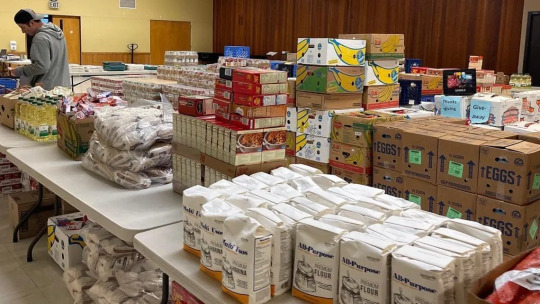
But this Thanksgiving, a longtime prayer of food bank leaders was finally answered: an anonymous benefactor donated the full $800,000 they needed to move out of a facility they've long outgrown. That benefactor, however, preferred to stay anonymous.
"Very private company, really don't want attention," said Debbie Christian, executive director of the Auburn Food Bank. "It's a goodhearted person that just wants to see the work here continue, wants to see it expand."
4. Empowering woman saving hopes and mental health of suffering Ukrainian kids

Kenza Hadij-Brahim is at the forefront of promoting Circle of Toys
Hadj-Brahim is helping to launch the Circle of Toys initiative. A project that provides Ukrainian children in need of some normality with preloved toys. This new initiative connects people with old toys they might otherwise throw away, with Ukrainian families in need who want to provide some comfort to their children in this distressing time.
Find Refuge said : “The endeavour is driven by a sincere purpose: spark joy, foster play, and bring a hint of normalcy back to the young lives in Ukraine.”
5. TWO LOST CITIES HIDDEN FOR CENTURIES WERE JUST DISCOVERED IN BOLIVIA

Researchers have found these areas not only housed structures and pyramids but it has been uncovered that there were advanced irrigation systems, earthworks, large towns, causeways, and canals that cover miles.
Dr. Heiko Prümers from the German Archaeological Institute, who was also involved in the study comments that “this indicated a relatively dense settlement in pre-Hispanic times. Our goal was to conduct basic research and trace the settlements and life there. The research sheds light on the sheer magnitude and magnificence of the civic-ceremonial centers found buried in the forest”.
6. Sheep dubbed Fiona rescued from cliff in Scotland where she was stuck for more than 2 years
youtube
And at last, some positive climate news:
7. Three positive climate developments
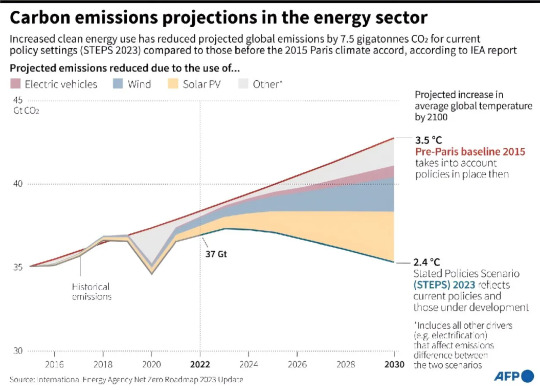
Heating
When the Paris Agreement was adopted, the global reliance on fossil fuels placed the world on a path towards a 3.5C rise in temperature by 2100. Eight years on, country commitments to reduce their carbon footprints have pulled that down slightly, putting the world on a path for a 2.5C to 2.9C by the end of the century.
Peak emissions
Annual greenhouse gas emissions responsible for climate change have risen roughly nine percent since COP21, according to UN data. But the rate of the increase has slowed significantly. Recent estimates by the Climate Analytics institute find global emissions could peak by 2024
Rising renewables
Three technologies—solar, wind and electric vehicles—are largely behind the improved global warming estimates since 2015.
---
That's it for this week :)
This newsletter will always be free. If you liked this post you can support me with a small kofi donation here:
Buy me a coffee ❤️
Also don’t forget to reblog this post with your friends.
814 notes
·
View notes
Text
Jobs (HC)
Fandom: Blackstar Theater Starless
Pairing: No pairing.
Warning: None
Prompt: What if they had 'normal' lives where Starless never existed, and neither did the sketchy organizations behind the scenes? What non-sketchy careers would they pursue?
A/N: Assume older age for the younger characters; they're not in school/college anymore.
———————————————
Kei
Celebrity - Actor/Singer/Model (of course, lol)
CEO & Founder of a Corporation
Owner of a Movie Production House
Sotestu
Stockmarket Investor
Professional Poker Player
Detective/Private Investigator
Yakou
Scientist
Reporter
Professor (his class 99% female students, lol)
Yoshino
Chess Player
Owner of a small business (inn or restaurant - girls flock there just to see his cuteness)
Freelancer
Ginsei
Celebrity (Model/Actor)
General Manager in a big company
Scriptwriter
Gui
Parkourist
Skateboarder or Snowboarder
In short, Athlete
Kokuyou
Boxer
Captain in the military
Personal Trainer (A LOT of the women want him to train them)
Akira
Boyband Member
Bartender
Model
Sin
Author
CEO of a big company
Head of a Secret Service Agency
Takami
Detective
Politician
Businessman
Taiga
Streamer
Programmer/Developer
Runs a computer repair shop
Rindou
Model
PCP/Family Doctor
Pediatrician (all the moms loooove going to him because he takes care of their kids really well...yeah, let's go with that.)
Maica
CEO of a company
Fashion Blogger
Music Composer/Singer
Menou
Professional Mattress Tester
Applier for every clinical sleep study possible
Real Estate Agent
Sinju
Working for a non-profit
Caretaker in an elderly home (the grandmas and grandpas love him to death)
Freelancer
Nekome
Surgeon (would you trust him? XD)
Politician
Police Officer
Mokuren
Professional Food Taster
Dancer/Dance Teacher
Food Critic
Qu
Beauty Pageant/Model Trainer
Professional Makeup Artist
Fashion Designer
Zakuro
Controversial YouTuber
Politician
Therapist (would you trust him?)
Hari
Software Engineer
Founder of a business
Researcher at a large institute
Kasumi
Secret Agent for the government
Martial Art Instructor
Physical Therapist
Aogiri
Fashion Designer
Nurse Practitioner
Yoga Instructor (his calmness makes me think this😂)
Mizuki
Food Taster
Skateboarder
Bad Cop
Kongou
Professional Chef
Gym Trainer/Bodybuilder
Wrestler (of course lol)
Heath
Florist
Underground Rapper
Environmentalist
Ran
Skateboarder
Dog Trainer
Idol
Rico
Model
Personal Fashion Designer
Casting Director
Hinata
Basketball Player
Tattoo Artist
Gym Instructor
Unei
9 to 5 Office Employee
Manager in a small company
———————————————
➣ BlackStar Theater Starless Masterlists [1][2][3][4]
➣ Main Masterlist
#bsts#blackstar theater starless#bsts kei#bsts sotetsu#bsts yoshino#bsts yakou#bsts ginsei#bsts gui#bsts kokuyou#bsts akira#bsts sin#bsts takami#bsts taiga#bsts rindou#bsts maica#bsts nekome#bsts sinju#bsts menou#bsts mokuren#bsts qu#bsts hari#bsts zakuro#bsts aogiri#bsts kasumi#bsts mizuki#bsts kongou#bsts ran#bsts rico#bsts heath#bsts hinata
30 notes
·
View notes
Text


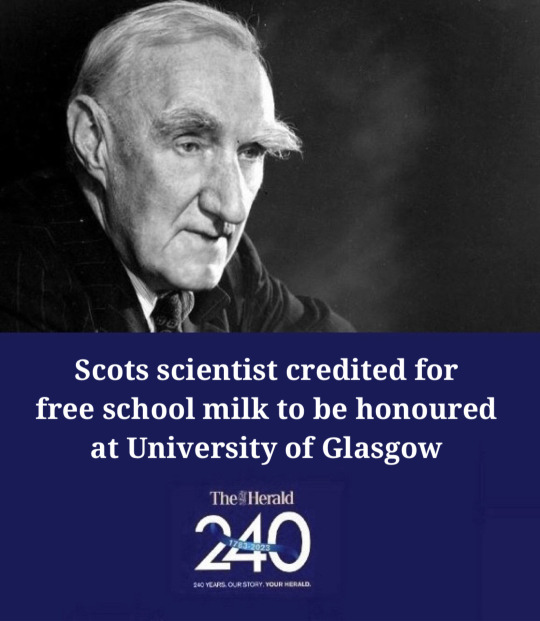
On September 23rd 1880, John Boyd Orr, Nobel Peace prize winner, was born in Kilmaurs, Ayrshire.
John Boyd Orr's pioneering research led to millions of children across the UK being given free school milk from 1946 to 1971 when Margaret Thatcher, then education secretary, cut provision giving her the mick name Thatcher, "Thatcher, Thatcher, milk snatcher”
Boyd Orr was born in Ayrshire into a religious and highly literate family, and it was perhaps inevitable that he should be destined for a career in teaching after studying theology. However, his studies at Glasgow University also opened up new avenues for him. He became interested in the theories of Darwin, and this led to a fascination with zoology.
When he graduated with his MA in 1902, he was assigned to a teaching position in the Glasgow slums to fulfil the obligations required by his scholarship. He lasted only a few days before resigning and going back home to Ayrshire where he was reassigned to a school in Saltcoats. There he completed his teaching but left as soon as he could, saying: "though I liked the children, I hated teaching them”.
Boyd Orr returned to university to study biology and medicine, and he graduated with a BSc in 1910 and MB ChB two years later. He only practised for one month before returning to university to undertake nutritional research. His MD thesis in 1914 was awarded the Bellahouston Gold Medal for the most distinguished thesis of the year.
On the recommendation of his supervisor, he was asked to be the first director of a new research institute in Aberdeen, which would later become the world renowned Rowett Institute. At the time of his appointment, it did not exist, but he would spend the next twenty-five years raising both funds and the profile of nutritional research to make it a reality.
The initial work to build the institute was, however, interrupted by the outbreak of war. Boyd Orr enlisted in the RAMC and saw active service on the Western Front where he was awarded both the Military Cross and the Distinguished Service Order. Later he would never wear the medals saying that the truly brave men had all died.
In the interwar years, he travelled widely and published extensively, emerging as one of the country’s leading experts in nutrition. He first came to national attention in 1936 with the publication of Food, Health and Income, a report of a dietary survey by income group, which revealed that the cost of a diet meeting basic nutritional needs was beyond the means of half the British population.
This led to similar studies being conducted in nineteen other countries and prompted the creation of a Commission of the League of Nations, which tried to formulate a global food policy. It became the forerunner of the United Nations Food and Agriculture Organization (FAO). Boyd Orr would become the Director General of the FAO from 1945-48. These were important years because the predicted European post-war famine was averted in part by policies put forward by the organisation.
Boyd Orr was no stranger to the challenges of developing and implementing food policies, many of which are still with us today. He spent his later career trying to persuade governments and presidents, organisations and companies to rethink the way they did things. However, he would often bemoan the fact that while he could persuade farmers of the importance of the nutrition of their animals, he could not stir their interest “in the food of their ain bairns, far less in the bairns of ither folks”.
His was a life filled with honours and awards, from Gold medals at University to military decorations to honorary degrees and more. He was elected Rector of Glasgow University and subsequently became its Chancellor. He was briefly a British Member of Parliament, and in 1935 he was knighted for his services to agriculture. In 1949, after he was awarded the Nobel Prize, Prime Minister Clement Attlee ennobled him as Baron Boyd Orr of Brechin Mearns.
Reading of Boyd Orr’s long career it seems he had a series of false starts and perhaps even failures. But he was no dilettante. He combined a powerful intellect with an admirable work ethic to achieve a mastery in everything he tried. That he chose to move from a career in teaching to medical practice, to research, to politics and then to governance and policy making was not evidence of mere restlessness but of a constant desire to do meaningful work.
Boyd Orr was at heart a man with an ambitious vision for the world, and he firmly believed that real peace and prosperity would only ever be achieved when no one was hungry.
The citation for the 1949 Nobel Peace Prize read: “for his lifelong effort to conquer hunger and want, thereby helping to remove a major cause of military conflict and war”.
21 notes
·
View notes
Text
Solar Farms Have a Superpower Beyond Clean Energy. (New York Times)
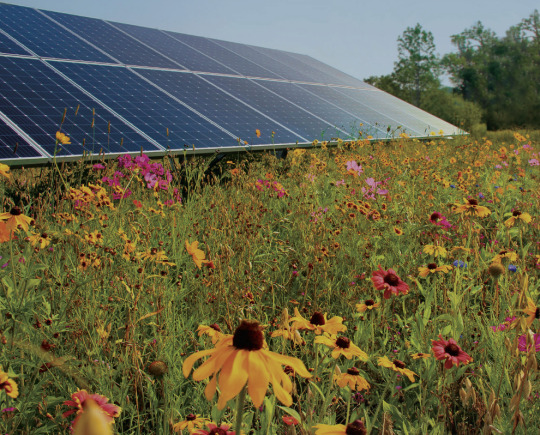
Excerpt from this New York Times story:
It’s not your average solar farm.
The glassy panels stand in a meadow. Wildflowers sway in the breeze, bursts of purple, pink, yellow, orange and white among native grasses. A monarch butterfly flits from one blossom to the next. Dragonflies zip, bees hum and goldfinches trill.
As solar projects unfurl across the United States, sites like this one in Ramsey, Minn., stand out because they offer a way to fight climate change while also tackling another ecological crisis: a global biodiversity collapse, driven in large part by habitat loss.
The sun’s clean energy is a powerful weapon in the battle against climate change. But the sites that capture that energy take up land that wildlife needs to survive and thrive. Solar farms could blanket millions of acres in the United States over the coming decades.
So developers, operators, biologists and environmentalists are teaming up with an innovative strategy.
“We have to address both challenges at the same exact time,” said Rebecca Hernandez, a professor of ecology at the University of California, Davis, whose research focuses on how to do just that.
Insects, those small animals that play a mighty role in supporting life on Earth, are facing alarming declines. Solar farms can offer them food and shelter by providing a diverse mix of native plants.
Such plants can also decrease erosion, nourish the soil and store planet-warming carbon. They can also attract insects that improve pollination of nearby crops.
Pollinator friendly solar can pay off for business, too, potentially saving money and giving projects an edge for approval at a time when communities are increasingly wary of vast solar farms. Developers are taking note.
But there’s a broad spectrum of pollinator friendliness and little agreement on what efforts should count. Standards are often nonexistent. Some big projects are limiting pollinator habitat to tiny corners of their sites. Ecological value varies widely.
Communities may not understand the difference, and corporate marketing may exaggerate. That’s led to accusations of greenwashing.
Pollinator habitat on solar farms is “a serious work in progress,” said Scott Black, executive director of the Xerces Society for Invertebrate Conservation, a nonprofit group that is working on an effort to bring some clarity by certifying solar sites.
“It’s not fair if some people are truly stepping up to do this right and another company is barely doing anything and saying they’re pollinator friendly,” he said.
“If you build it, will they come?” he asks in his research. So far the answer is a resounding yes, if you grow the right plants.
In a study published late last year, his team found that insect abundance had tripled over five years on test plots at two other Minnesota solar sites. The abundance of native bees grew twentyfold.
The results come amid a global decline of wildlife that leaders are struggling to address. Some of the most well-known insect species are in trouble: Later this year, the federal government is expected to rule on whether to place monarch butterflies on the Endangered Species List. North American birds, for their part, are down almost 30 percent since 1970.
But at this site, called Anoka County Solar, acoustic monitoring has documented 73 species of birds, presumably attracted by the buffet of seeds and insects. Some build nests in the structures supporting the panels.
Mammals are showing up, too. Mr. Walston checked a trail camera before leaving, hoping to discover the occupant of a remarkably large burrow: A fox, he thought, or a badger. No luck.
(It’s trickier to make solar sites friendly to large wild animals, in part because developers are nervous to let them near expensive infrastructure, but efforts are underway there, too.)
What makes this meadow possible is the height of the panels. A prairie restoration firm had told ENGIE, the owner and developer, that taller panels would allow for a sharp increase in native vegetation species, providing much more ecological diversity, said John Gantner, the director of engineering and delivery for ENGIE’s smaller-scale sites.
26 notes
·
View notes